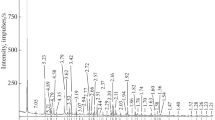Abstract
The study shows the analysis of the various Roman mortars in the survival structure of the Danube Bridge in Drobeta-Turnu Severin, Romania, which is particularly relevant, and the results provided will help clarify the technology used for its construction through spectral, XRD and thermoanalytic techniques. It is intended to establish similarities or differences between the studied subjects. This paper highlights the complementary nature of the various techniques: XRD for the identification of major crystalline phases, FTIR for a more detailed evaluation of the composition comprising non-crystalline and TGA phase for the quantitative determination of volatile phases (especially CO2 and H2O).

Source: Google Earth™ Pro, Image snapshot processed by authors on 08.10.2018





Similar content being viewed by others
References
Anastasiou M, Hasapius Th, Zorba T, Pavlidou E, Chrissafis K, Paraskevopoulos KM. TG-DTA and FTIR analyses of plasters from byzantine Monuments in Balkan region- comparative study. J Therm Anal Calorim. 2006;84–1:27–32.
Vecchio S, La Gmestra A, Frezza A, Ferragina C. The use of thermoanalytical techniques in the characterization of ancient mortars. Thermochim Acta. 1993;227:215–23.
Silva DA, Wenk HR, Monteiro PJM. Comparative investigation of mortars from Roman Colosseum and cistern. Thermochim Acta. 2005;438:35–40.
Duran A, Perez-Maqueda LA, Poyato J. A thermal study approach to roman age wall painting mortars. J Therm Anal Calorim. 2010;99:803–9.
Corti C, Rampazzi L, Bugini R, Sansonetti A, Biraghi M, Castelletti L, Nobile I, Orsenigo I. Thermal analysis and archaeological chronology: the ancient mortars of the site of Baradello (Como, Italy). Thermochim Acta. 2013;572:71–84.
Biscontin G, Pellizon Birelli M, Zendri E. Caracterization of binders employed in the manufacture of Venetian histotical mortars. J Cult Herit. 2000;3:31–7.
Vittorio G. I ponti romani. Catalogo generale, vol. 2. Treviso: Edizioni Canova; 1994.
Griggs FE. Trajan’s bridge: the world’s first long-span wooden bridge. Civ Eng Pract. 2007;22–1:19–50.
Nemţeanu R. Trajan’s bridge at Drobeta-Turnu Severin build by the architect Apollodorus. ARA Rep. 2011;2:113–26.
Bara M, Kaiser S. Roman bridges on the lower part of the Danube. Bull Transilv Univ Braşov—CIBv. 2015;8–57:193–8.
Serban M. Trajan’s Bridge over the Danube. IJNA. 2009;38–2:331–42.
Vučković D, Mihajlović D, Karović G. Trajan’s Bridge on the Danube. The current results of underwater archaeological research. Istros. 2007;14:119–30.
Irimuş IA, Neagoe O. Vulnerabilities induced by relief in the location of the Roman geosites in Drobeta area. Riscuri şi Catastrofe. 2017;16(20–1):173–84.
Amer AA, El-Hoseny S. Properties and performance of metakaolin pozzolanic cement pastes. J Therm Anal Calorim. 2017;129:33–44.
Kani EN, Allahverdi A, Provis JL. Calorimetric study of geopolymer binders based on natural Pozzolan. J Therm Anal Calorim. 2017;127:2181–90.
Zhi Z, Ma B, Jian S, Guo Y, Yu H, Tan H, Chen F. Thermal analyses effect of cellulose ethers on hydration of high-strength gypsum. J Therm Anal Calorim. 2017;129:1547–54.
Scheinherrova L, Dolezelova M, Havlın J, Trnık A. Thermal analysis of ternary gypsum-based binders stored in different environments. J Therm Anal Calorim. 2018;133:177–88.
Moropoulou A, Bakolas A, Bisbikou K. Characterization of ancient byzantine and later historic mortars by thermal and X-ray diffraction techniques. Thermochim Acta. 1995;270:779–95.
Bakolasa A, Biscontina G, Moropouloub A, Zendria E. Characterization of structural byzantine mortars by thermogravimetric analysis. Thermochim Acta. 1998;321:151–60.
Montoya C, Lanas J, Arandigoyen M, Navarro I, Garčıa Casado PJ, Alvarez JI. Study of ancient dolomitic mortars of the church of Santa Marıa de Zamarce in Navarra (Spain): comparison with simulated standards. Thermochim Acta. 2003;398:107–22.
Acknowledgments
Manny thanks to dr. arhg. Oana Neagoe and dr. arhg. Marin Neagoe from MUSEUM OF THE IRON GATES REGION, for provided samples.
Author information
Authors and Affiliations
Corresponding author
Additional information
Publisher's Note
Springer Nature remains neutral with regard to jurisdictional claims in published maps and institutional affiliations.
Rights and permissions
About this article
Cite this article
Moşoiu, C., Vlase, D., Vlase, G. et al. TG-DTA and FTIR analyses of roman and later historic mortars from Drobeta-Turnu Severin region. J Therm Anal Calorim 138, 2159–2166 (2019). https://doi.org/10.1007/s10973-019-08508-x
Received:
Accepted:
Published:
Issue Date:
DOI: https://doi.org/10.1007/s10973-019-08508-x




